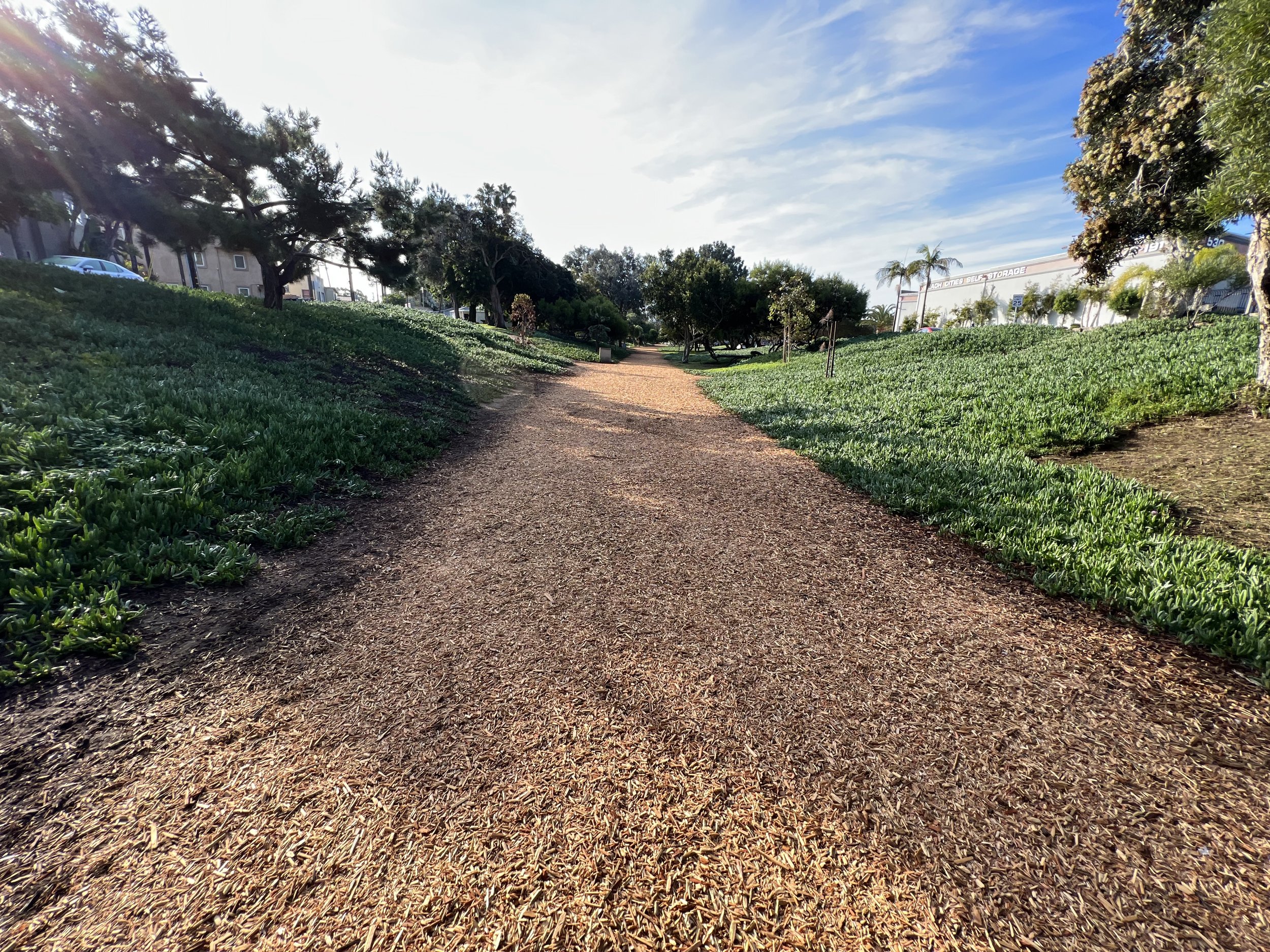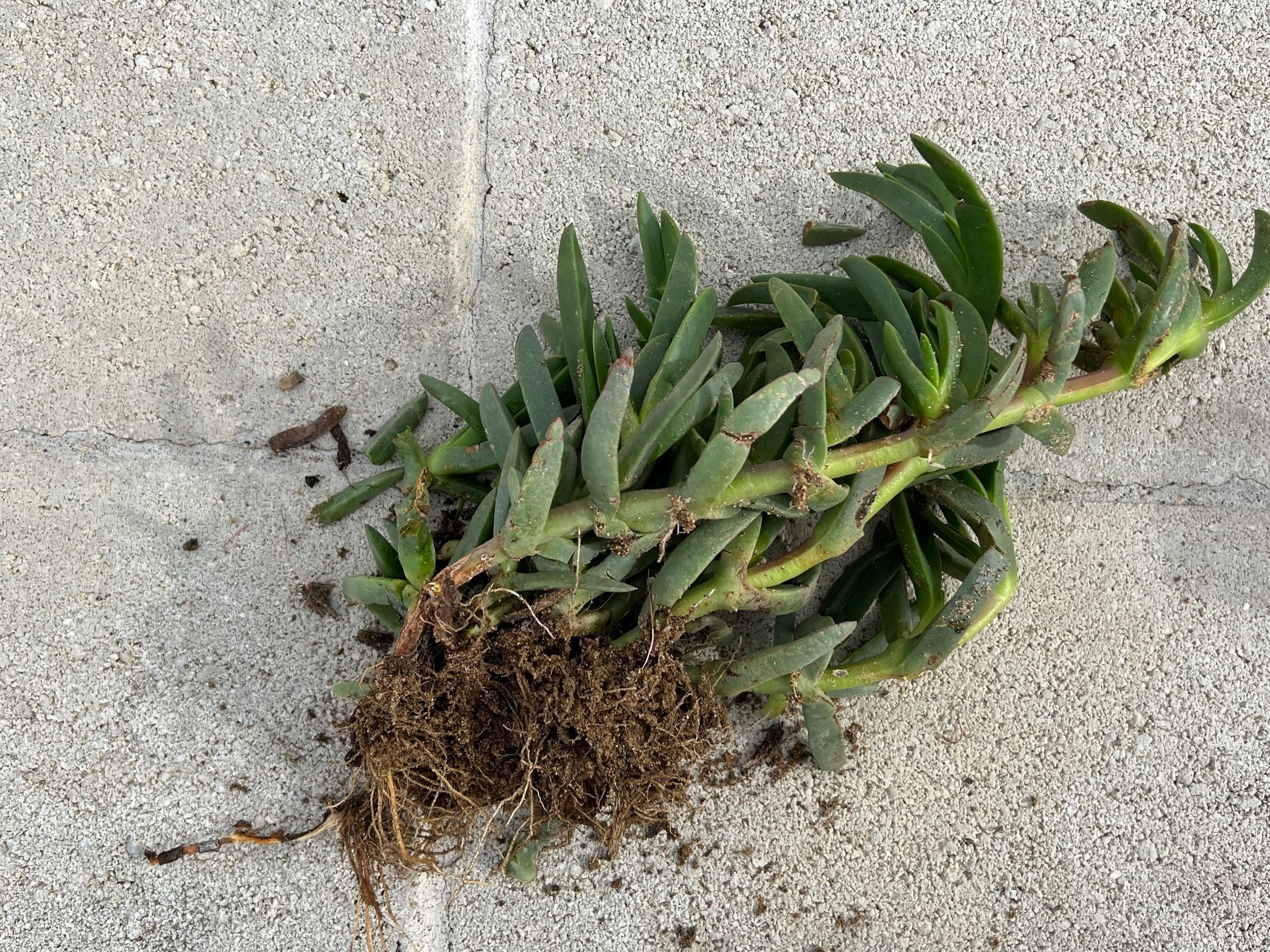SO WHAT’S WRONG WITH ICE PLANT???
You may have heard that ice plant is bad. But you may have wondered what is wrong with it?
It stays green most of the time. It does well in droughts. It looks pretty when it flowers. It seems to be everywhere. How can that be bad? There’s so much of it, isn’t it native to California? If you’ve wondered about these things, you are not alone.
How did it get here?
Because it is so ubiquitous on our coast, many think that ice plant must be native. But it is not. The kind of ice plant we see most is technically Carpobrutus edulis or the Hottentot fig ice plant. Cool name, huh? It is actually a native of South Africa. The coastal climate is similar to California’s coast. Temperatures average around 63 degrees Fahrenheit, most of the rain is in winter and summers are fairly dry.
As railroad tracks were laid up and down the coast of California starting after the mid-1800s, the railroads were looking for a quick way to stabilize the soil around their newly constructed tracks. So they spread ice plant because it thrived in our coastal conditions and spread quickly with no care required. As the state started to build statewide highway systems, they took their cue from the railroads, and near the coast, they spread ice plant on the sides of new roads. From the ribbons of highways and train tracks, the ice plant spread and spread. Now over 100 years later, it is a dominant plant on the coast. So now we know it is not native and how it came to be widespread, but that still doesn’t answer:
Why is ice plant so bad?
The answer is complex and multi-faceted. So let’s break it down into some bite-sized chunks.
Ice plant is invasive - —What does “invasive” mean? First, we already know ice plant is not native. That means technically it is an “exotic” plant. Exotics that multiply quickly and are hard to control are called “invasive”. Ice plant is obviously invasive… we can see how it spread from roadsides and railroad tracks to cover much of our coast. In fact, each ice plant grows about 3 feet per year. And each individual plant can grow to a 165 foot diameter. The seeds spread easily by wind, water, and by animals. And a chunk of ice plant that lands on the ground can start a whole new plant. So if a coyote breaks off a piece and it rolls onto bare ground, it is spreading the ice plant.
Ice plant forms a monoculture —Monoculture means an area is dominated by a single plant. A grass lawn is a monoculture. Some people spend a lot of time and money to maintain that monoculture. Ice plant forms a monoculture all on its own. How does it do that? Simply put, It kills off the pre-existing native plants. We already know ice plant spreads fast and easily. It quickly forms thick interwoven mats. Those mats block the sun that other plants and their seeds need to grow and survive. Choking out the sunlight is one way ice plant kills off its competitors to form a monoculture. But ice plant beats out the competing native plants another way, it uses chemical warfare! The coast is an environment rich in salt. Ice plant thrives on it and concentrates that salt. As older leaves on lower layers of ice plant mats die off and fall to the soil the concentrated salt is passed to the soil. This makes it difficult for seeds from native plants to sprout. So our ice plant is quite the killing machine… first, it spreads fast, then it chokes out the sunlight, then it salts the soil!
3. Ice plant does not support local insects and pollinators —Because ice plant is from South Africa, none of our native insect species evolved to thrive on ice plant. While a native California bush sunflower is the host species for 73 native butterfly and moth species, Hottentot fig ice plant is not a host for any – zero, zip, zilch. A host plant is one that is a food source for the larvae (a caterpillar in the case of butterflies and moths) of an insect species. Plants would die off if any insect could consume every plant. So plants develop defense mechanisms that deter insect larvae from feeding on it. Over the millennia certain species of insects have paired up with certain plant species to form a relationship. The insects evolve to defeat the plant’s defense mechanism, but the insects don’t reproduce so much that they kill the plant species. Some insects are very selective. For example, the endangered El Segundo blue butterfly evolved such that its only host plant is seacliff buckwheat. As seacliff buckwheat was destroyed by invasive species and development, the El Segundo blue nearly went extinct. Monarch butterflies are not as picky as the El Segundo blue, but their caterpillars can only eat milkweed plants. They are not picky about which milkweed plant, so they have a slightly wider diet than El Segundo blues. But as you can see, as ice plant forces out native plants, there are fewer and fewer native host plants for our insects.
As to pollinators, ice plant flowers certainly can provide pollen to pollinators such as bees and butterflies. The problem is ice plant only flowers a few months each year. So what? Most plants have a limited flowering season. Well, normally, we would have a diversity of native flowering plants that would in aggregate produce flowers year-round. The monoculture created by ice plant eliminates the mix of plant species that ensure the year-round availability of flowers. Also, in general, ice plant has few flowers per square yard. So ice plant eliminates pollen to pollinators for most of the year and provides less even when it does flower. Our area is an overwintering area for monarch butterflies. Those monarchs need pollen during the winter months. Ice plant does not flower in winter. So we can see why ice plant is bad for bugs and pollinators. But that is just the start.
4. Ice plant impacts biodiversity —As we move up the food chain, as the insect species struggle, the larger species begin to suffer from a lack of food sources. All sorts of birds, reptiles, and mammals rely on insects for their food supply. As the population of insects decreases, the populations of these birds, reptiles, and mammals suffer. And then the carnivores that rely on the insect-eating animals begin to suffer. As lizards, small mammals, and reptile populations fall, hawks, falcons, owls, herons, and other carnivores lose their food sources and their populations collapse. The entire food chain/web begins to fall apart. Ice plant forms a veritable desert that ripples through the entire food chain. If you enjoy birds, butterflies, and wildflowers, ice plant is your enemy.
5. Ice plant is not even good at what it was planted for — All this goes back to the railroads trying to stabilize the soil near their tracks. It turns out ice plant is horrible at that job. While the original plant may have roots that go down 18 inches, as the plant spreads the new nodes put out shallow roots that are usually 3 inches and up to 6 inches deep. That is not enough to stabilize soil – especially on slopes. Compare that to a native plant. Native California plants generally put down deep tap roots to bring up moisture from way underground.
A single mature seacliff buckwheat plant puts down roots that go down 12 feet and out 12 feet around the base of the plant. That provides much more holding power than 3 to 6-inch roots. To add insult to injury, on steeper slopes, ice plant can actually contribute to soil destabilization and erosion. During winter rains the leaves of the ice plant plump up and gain weight. That added weight can exceed the holding power of the shallow roots and the ice plant can slide down the slope dragging top soil with it and exposing the loamy soil beneath to rapid erosion. Some plant ice plant around their home thinking it is a good fire barrier. Well, that may be true during the rainy season. But as the ice plant dries out, it actually becomes quite flammable.
So folding all that together….
A simple question has resulted in a pretty long answer. We hope that you now understand why ice plant is so bad for our local ecosystems and why we need to restore native plants that will serve as a foundation for stronger ecosystems. We can never eradicate all ice plant. It is too widespread in places that are inaccessible.
But we can work to reduce its dominance and provide critical islands of biodiversity crucial to the survival of California species. We hope that this will also provide the incentive for some of you to pitch in… to plant native plants in your own yard or on your balcony or porch, to volunteer on rewilding projects in the South Bay, or to donate to rewilding projects. At the very least, if you hear someone complain about someone ripping out ice plant, you can provide an explanation of why they are doing it.
Resources:




